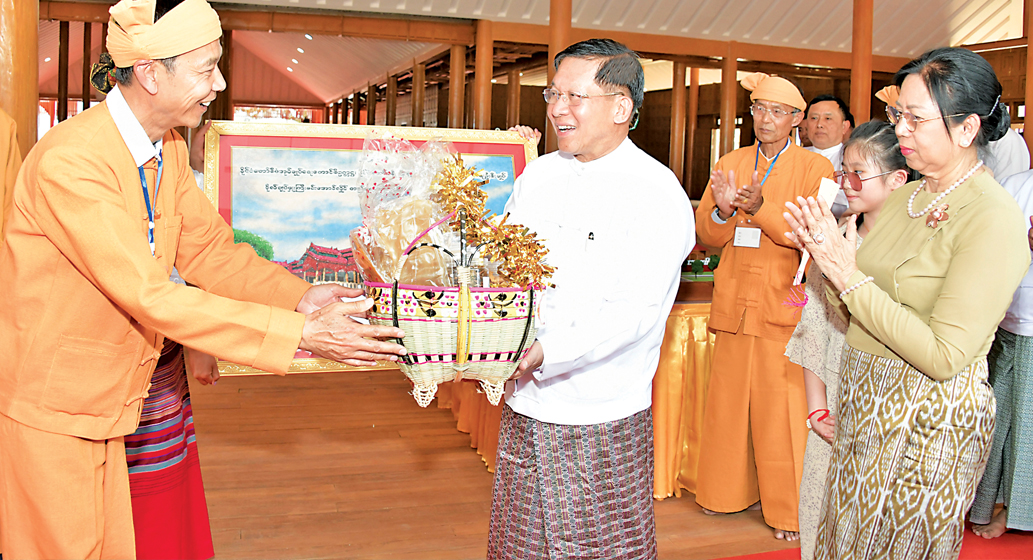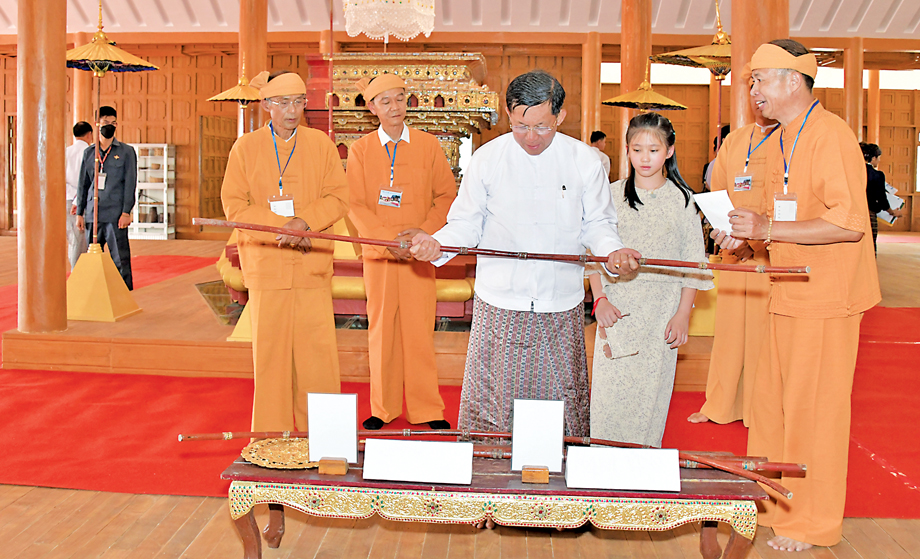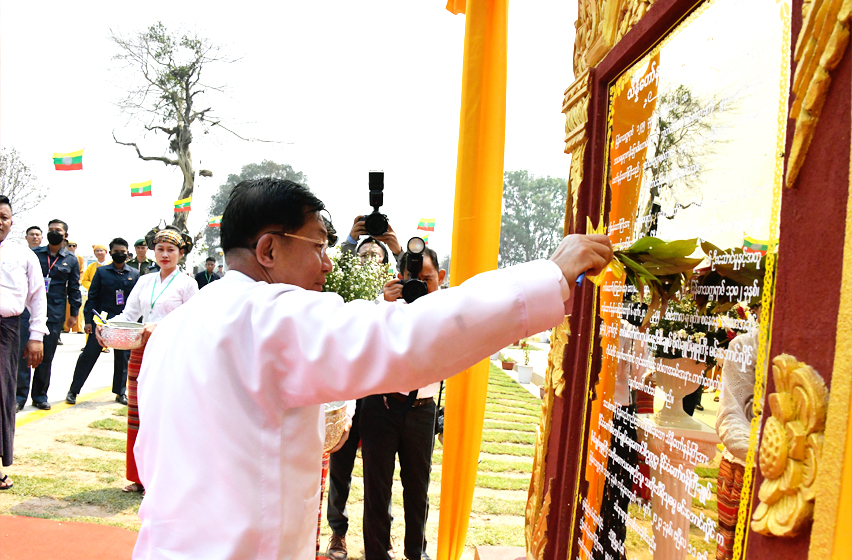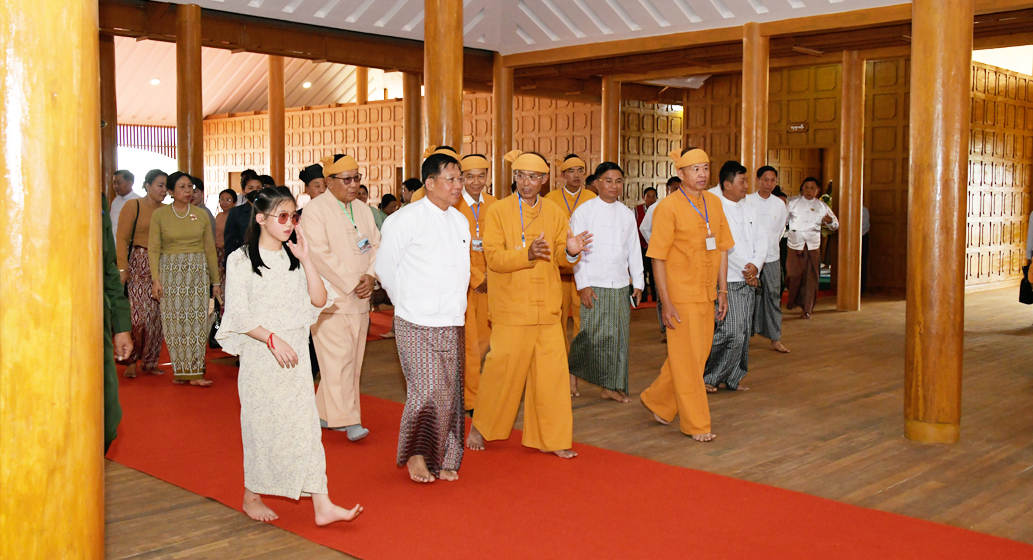Haw Palace (Haw kham Shan Wi) of Hsenwi Saopha Hkun Hsang Tone Hung inaugurated as Hsenwi Haw Palace Cultural Museum
NAY PYI TAW April 11
Chairman of the State Administration Council Prime Minister Senior General Min Aung Hlaing inaugurated the rebuilt Haw Palace (Haw kham Shan Wi) of Hsenwi Saopha Hkun Hsang Tone Hung as Hsenwi Haw Palace Cultural Museum this morning.
Also present at the ceremony were Daw Kyu Kyu Hla, wife of the Senior General, Joint Secretary Council members Admiral Tin Aung San, Dr Kyaw Tun, Khun San Lwin, U Shwe Kyein and U Yan Kyaw, Union Ministers U Khin Maung Yi and U Aung Thaw, Shan State Chief Minister U Aung Zaw Aye, Commander-in-Chief (Navy) Admiral Moe Aung and wife, Commander-in-Chief (Air) General Tun Aung and wife, senior military officers of the Office of the Commander-in-Chief and their wives, Commanderof North East Command Maj-Gen Naing Naing Oo, wellwishers and local people.
Warmly welcome with traditional Ozi dances On arrival at the site where the ceremony to open the museum, the Senior General and party were warmly welcomed by Lashio District Deputy Commissioner U Myo Min Tun, departmental officials, town elders, people’s militia members and local ethnic people with traditional dances.
Then, the opening of Haw Palace (Haw kham Shan Wi) rebuilt as Hsenwi Haw Palace Cultural Museum followed.
Speaking on the occasion, the Senior General said that he was glad to meet all ethnic people attending today’s Hsenwi cultural museum opening ceremony and expressed his wish for all to be physical and mental wellbeing.
Shan State including northern Shan State comprising Hsenwi Township is the largest among other 14 regions and states in the Union. It is a state with significant characteristicswith residences of many ethnic people. In looking back the history of ShanState, Saophas in Shan plateau had been loyal to the Myanmar kings insuccessive eras and actively participated in the serving the State interestsand in serving the national defence duties.
In the reign of King Hsinbyushin Myedu (Thiri Dhammaraja) in the early Konbaung dynesty, Chinese troops attacked Kengtung in 1127 ME, Bhamo in 1128 ME and Hsenwi in 1129 ME.
Shan Saopha troops cooperated with Myanmar king’s troops in successfullycounterattacking the Chinese troops. Moreover, Shan Saophas organize theirpeople holding any arms to fight against aggressive wars of Britishcolonialists. For example, Wuntho Saopha U Aung Myat was a patriotic person inbravely fighting British colonialists.
The Senior General said he would like to explain north Hsenwi region in connection with the opening of Hsenwi Haw Palace ceremony. In the past, Saophas who ruled northern part of Shan State based in Hsenwi. The Haw palace built by north Hsenwi Saophain 1910 was destroyed by fire in bomb attacks in April 1944. The global history showed kingdom countries, the states ruled by Maharajas and Saophas. Some countries shifted the administrative systems to the democratic systems.
Myanmar reformed the democratic administration called the people’s administration in Shan State in 1959. But, the history can never be destroyed and it is necessaryto take lessons from the past events to reach the better system. History must be approved. The Senior General expressed his concept
that the history of Saophas of Shan State must be exposed and maintained. As request of the local people,the government and the Tatmadaw rebuilt the Haw palace as a symbol of unity of the local ethnic people as a historical building in the region.
Likewise,Mongpun Haw Palace has been renovated whereas Kengtung Haw Palace is underway for replica construction. It is sure that the Haw palace will contribute to increase of local and foreign travellers to the region for its development.
Sao Hone Pha, who succeeded his father Sawbwa Khun San Ton Hone, was the last Sawbwa of northern Hsenwi, who served his best in military and civil affairs for the sake of the Union.
In 1944-1945, he mobilized local people and led them in fighting against the Japanese. He was also one of the leading Shan Sawbwas to sign in the historic Panglong Agreement on 12 February 1947. On 28 March 1948 when white Yebaws and red Communist troops tried to occupy Lashio, he together with his police fought back by rounding up local people. In the same month, the town could be retaken and handed over to the then government. Sawbwa Sao Hone Pha served as a gazetted officer of Magway District and No.14 Burma Refile Battalion until he reached the rank of major.
He served as chairman of the Shan State government from 1958 to 1960. On Independence Day in 1949, Thadoe Maha Thray Sithu title was conferred on him for his courage and patriotism.
In retrospect, under the leadership of successive northern Hsenwi Sawbwas, local people and ethnics unitedly took part in national defence tasks and the fight against the colonialists and Japanese fascists. To recognize this, the State and Tatmadaw rebuilt the Hsenwi Palace as a landmark and historic building and as a gesture showing unity of Hsenwi town.
And I am honoured to see this and believe that the local people will also be delighted.
This new Hsenwi Palace is the pride of Hsenwi town. I am also glad to hear that under the leadership of the Township Shan Literature and Culture Association, the local people will continue their efforts to make it a historic cultural museum for the recreational and knowledgeable center for the people. It is also learnt that religious events will be held there. So, I would like to urge the local ethnics and departmental personnel to cooperate in conserving Hsenwi Palace for its long existence.
Heartfelt thanks for rebuilding the historic Hsenwi Palace
Speaking words of thanks, U Sai Myo Nyunt, chairman of the cooperation committee for rebuilding the palace, said the Township Shan Literature and Culture Association requested the Tatmadaw for rebuilding the palace, which fell to ground due to bombings in World War II, without harming the original style. On behalf of the local people, I express my deepest thanks for helping rebuild the palace under the leadership and guidance of the original donor, SAC Chairman Prime Minister Senior General Min Aung Hlaing. I am also honoured to see the Head of State himself give his supervision and guidance in foundation laying and construction tasks.
In our country, since ancient times, local ethnic people such as Shan, Kachin, Kokant, Wa, Palaung, Lahu and Lisu have been residing in the whole northern Shan State including Hsenwi town in unity and in weal and woe. A magnificent building has emerged thanks to the rebuilding of the palace, a cultural heritage of Hsenwi town without harming the original style. It is a landmark that can facilitate regional development and unity reflecting the pride of the Union. He then reiterated his thanks to the State, Tatmadaw and all other administrative bodies, departmental organizations and donors for rebuilding the palace.
After that, member of the State Administration Council Dr Kyaw Tun, Shan State Chief Minister U Aung Zaw Aye, Quartermaster General Lt-Gen Kyaw Swa Lin, Commander of Northeast Command Maj-Gen Naing Naing Oo, Chairman of the Shan Literature and Culture Association of Hsenwi Township U Sai Myint Tun, and township elders U Sai San Nyunt and U Sai Khaing Win cut the ribbon to open the Hsenwi Haw Palace Cultural Museum.
Then, the Senior General opened the Hsenwi Haw Palace Cultural Museum's inscription with a mechanical press and sprinkled scented water.
After that, the Senior General, and those who attended the ceremony took a photo together.
After that, the Senior General and those who attended the ceremony paid their respects to the ancient images of the Buddha worshiped by the Sawbwas, including the Sawbwa Hkun Hsang Tone Hung, in the Pagoda Hall of the Hsenwi Haw Palace Cultural Museum and offered flowers, water and oil lights. After looking at the ancient cultural artefacts, photographs of equipment used by successive Sawbwas and photos of the history of the reconstruction of Haw Palace in the museum and following the presentations of the officials, Senior General ordered that some of the antiques should be placed in glass displayed cabinets in order to prevent them from being damaged, and that other necessary things should be done.
After that, an official from the Shan Literature and Culture Association presented the Senior General and his wife with paintings and local gifts commemorating the opening of the Hsenwi Haw Palace Cultural Museum, and the newly completed reconstruction of the Haw Palace of the Sawbwa Hkun Hsang Tone Hung (Hawkham Shan Wi) and the Senior General presented the souvenirs.
After the ceremony, the Senior General, his wife and members welcomed the New Year together with department officials, members of the militia and the local ethnic people by sprinkling traditional Burmese Ata Thingyan water. After that, when the Senior General, his wife and members left, departmental officials and local indigenous people warmly waved goodbye to them.
The Hsenwi Haw Palace was built in 1910 AD, in the year 1272, as a grand and magnificent palace by the Hsenwi Sawbwa Hkun Hsang Tone Hung, who had the title of Dasdharma Raja Nigodha Mahaminkhao. It was built in the style of Mandalay Palace using teaks, and it is a structure that includes many buildings connected to each other in one big building. In the middle, there is a large conference hall and a hollow throne. After 33 years of the reign, the Sawbwa died of a heart attack in 1916 AD, in the year 1277, at 1:00 am on Tuesday after midnight, on the 2nd day of the Tagu waxing moon. In 1937 AD, in the year 1299, the Japanese air force bombarded the entire Shan State (northern), and in 1940 AD, Hsenwi was completely occupied by the Japanese. In 1944 AD, American warplanes bombed and destroyed the Hsenwi Namtu Bridge and also bombed Hsenwi town. As a result of the bombardment, a lot of damage was caused, and the royal palace of Hkun Hsang Tone Hung, who was prominent in history, also damaged. After that, according to the guidance of the Commander-in-Chief of the Defence Services Senior General Min Aung Hlaing, the reconstruction work of Haw Palace was started on December 5, 2019. It is reported that the new Haw Palace building was built 63 feet away from the left of the original building, and today, the opening ceremony of the newly reconstructed Haw Palace of the Sawbwa Hkun Hsang Tone Hung (Haw kham Shan Wi) as the Hsenwi Haw Palace Cultural Museum was successfully held, and thousands of local people attended and cheered.














